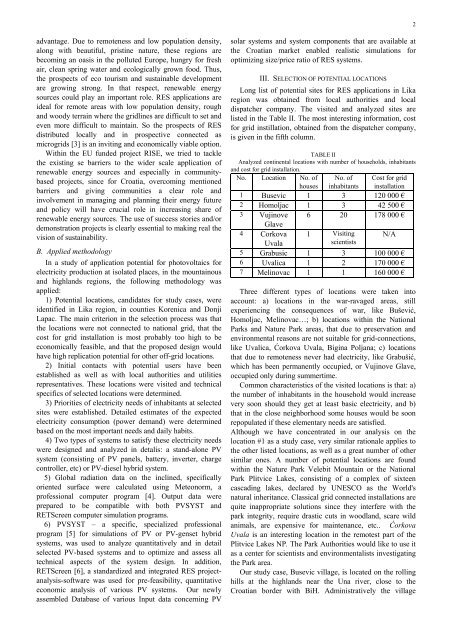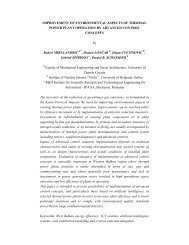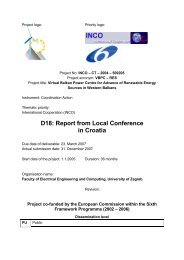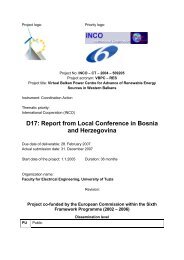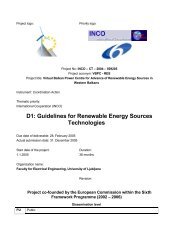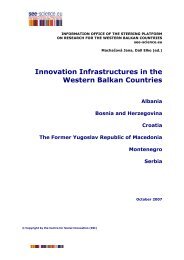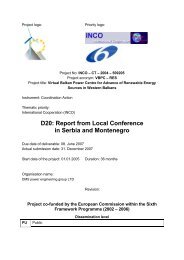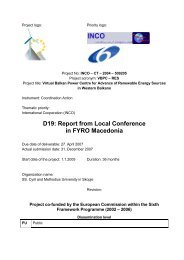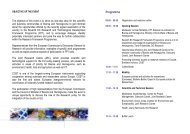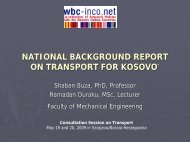Prva stran - WBC-INCO Net
Prva stran - WBC-INCO Net
Prva stran - WBC-INCO Net
You also want an ePaper? Increase the reach of your titles
YUMPU automatically turns print PDFs into web optimized ePapers that Google loves.
advantage. Due to remoteness and low population density,<br />
along with beautiful, pristine nature, these regions are<br />
becoming an oasis in the polluted Europe, hungry for fresh<br />
air, clean spring water and ecologically grown food. Thus,<br />
the prospects of eco tourism and sustainable development<br />
are growing strong. In that respect, renewable energy<br />
sources could play an important role. RES applications are<br />
ideal for remote areas with low population density, rough<br />
and woody terrain where the gridlines are difficult to set and<br />
even more difficult to maintain. So the prospects of RES<br />
distributed locally and in prospective connected as<br />
microgrids [3] is an inviting and economically viable option.<br />
Within the EU funded project RISE, we tried to tackle<br />
the existing se barriers to the wider scale application of<br />
renewable energy sources and especially in communitybased<br />
projects, since for Croatia, overcoming mentioned<br />
barriers and giving communities a clear role and<br />
involvement in managing and planning their energy future<br />
and policy will have crucial role in increasing share of<br />
renewable energy sources. The use of success stories and/or<br />
demonstration projects is clearly essential to making real the<br />
vision of sustainability.<br />
B. Applied methodology<br />
In a study of application potential for photovoltaics for<br />
electricity production at isolated places, in the mountainous<br />
and highlands regions, the following methodology was<br />
applied:<br />
1) Potential locations, candidates for study cases, were<br />
identified in Lika region, in counties Korenica and Donji<br />
Lapac. The main criterion in the selection process was that<br />
the locations were not connected to national grid, that the<br />
cost for grid installation is most probably too high to be<br />
economically feasible, and that the proposed design would<br />
have high replication potential for other off-grid locations.<br />
2) Initial contacts with potential users have been<br />
established as well as with local authorities and utilities<br />
representatives. These locations were visited and technical<br />
specifics of selected locations were determined.<br />
3) Priorities of electricity needs of inhabitants at selected<br />
sites were established. Detailed estimates of the expected<br />
electricity consumption (power demand) were determined<br />
based on the most important needs and daily habits.<br />
4) Two types of systems to satisfy these electricity needs<br />
were designed and analyzed in detalis: a stand-alone PV<br />
system (consisting of PV panels, battery, inverter, charge<br />
controller, etc) or PV-diesel hybrid system.<br />
5) Global radiation data on the inclined, specifically<br />
oriented surface were calculated using Meteonorm, a<br />
professional computer program [4]. Output data were<br />
prepared to be compatible with both PVSYST and<br />
RETScreen computer simulation programs.<br />
6) PVSYST – a specific, specialized professional<br />
program [5] for simulations of PV or PV-genset hybrid<br />
systems, was used to analyze quantitatively and in detail<br />
selected PV-based systems and to optimize and assess all<br />
technical aspects of the system design. In addition,<br />
RETScreen [6], a standardized and integrated RES projectanalysis-software<br />
was used for pre-feasibility, quantitative<br />
economic analysis of various PV systems. Our newly<br />
assembled Database of various Input data concerning PV<br />
solar systems and system components that are available at<br />
the Croatian market enabled realistic simulations for<br />
optimizing size/price ratio of RES systems.<br />
III. SELECTION OF POTENTIAL LOCATIONS<br />
Long list of potential sites for RES applications in Lika<br />
region was obtained from local authorities and local<br />
dispatcher company. The visited and analyzed sites are<br />
listed in the Table II. The most interesting information, cost<br />
for grid instillation, obtained from the dispatcher company,<br />
is given in the fifth column.<br />
TABLE II<br />
Analyzed continental locations with number of households, inhabitants<br />
and cost for grid installation.<br />
No. Location No. of No. of Cost for grid<br />
houses inhabitants installation<br />
1 Busevic 1 3 120 000 €<br />
2 Homoljac 1 3 42 500 €<br />
3 Vujinove<br />
Glave<br />
6 20 178 000 €<br />
4 Corkova 1 Visiting N/A<br />
Uvala<br />
scientists<br />
5 Grabusic 1 3 100 000 €<br />
6 Uvalica 1 2 170 000 €<br />
7 Melinovac 1 1 160 000 €<br />
Three different types of locations were taken into<br />
account: a) locations in the war-ravaged areas, still<br />
experiencing the consequences of war, like Bušević,<br />
Homoljac, Melinovac…; b) locations within the National<br />
Parks and Nature Park areas, that due to preservation and<br />
environmental reasons are not suitable for grid-connections,<br />
like Uvalica, Ćorkova Uvala, Bigina Poljana; c) locations<br />
that due to remoteness never had electricity, like Grabušić,<br />
which has been permanently occupied, or Vujinove Glave,<br />
occupied only during summertime.<br />
Common characteristics of the visited locations is that: a)<br />
the number of inhabitants in the household would increase<br />
very soon should they get at least basic electricity, and b)<br />
that in the close neighborhood some houses would be soon<br />
repopulated if these elementary needs are satisfied.<br />
Although we have concentrated in our analysis on the<br />
location #1 as a study case, very similar rationale applies to<br />
the other listed locations, as well as a great number of other<br />
similar ones. A number of potential locations are found<br />
within the Nature Park Velebit Mountain or the National<br />
Park Plitvice Lakes, consisting of a complex of sixteen<br />
cascading lakes, declared by UNESCO as the World's<br />
natural inheritance. Classical grid connected installations are<br />
quite inappropriate solutions since they interfere with the<br />
park integrity, require drastic cuts in woodland, scare wild<br />
animals, are expensive for maintenance, etc.. Ćorkova<br />
Uvala is an interesting location in the remotest part of the<br />
Plitvice Lakes NP. The Park Authorities would like to use it<br />
as a center for scientists and environmentalists investigating<br />
the Park area.<br />
Our study case, Busevic village, is located on the rolling<br />
hills at the highlands near the Una river, close to the<br />
Croatian border with BiH. Administratively the village<br />
2


